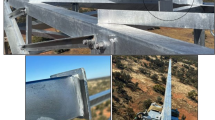Abstract
Existing steel girder bridges have often suffered damage at the girder ends during large-scale earthquakes. Against such damage cases, experimental and analytical studies on the failure behavior of steel girder end under lateral force have been carried out so far. However, there are still few study cases focusing on the three-dimensional behavior and load-carrying capacity of the whole superstructure system. In this paper, pushover analyses with nonlinear finite element models were performed for a composite steel I-girder bridge in order to investigate the damage mechanism and load-carrying capacity at the girder end under seismic lateral force in the longitudinal and transverse direction. In addition, parametric studies on the effect of additional reinforcing ribs at the pin support area on the load-carrying capacity was conducted. Pushover analyses clarified the damage behavior at the girder ends, including the plasticization and deformation process of each steel component, and also revealed that the load-carrying capacity in the transverse direction is smaller than that in the longitudinal direction. It was found that reinforcing ribs provide a resistance function against lateral forces not only in the longitudinal direction but also in the transverse direction and improve the load-carrying capacity.




















Similar content being viewed by others
References
Arimura, K., Ariyama, D., Hunakoshi, H., & Yamaguchi, T. (2017). Analytical study of load carrying capacity of I-girder bridge with corrosion. Journal of Japan Society of Civil Engineers A1 (structural and Earthquake Engineering), 73(1), 232–247. (In Japanese).
Japan Road Association. (1964). Japanese specifications for highway bridges. (In Japanese).
Japan Road Association. (2017). Japanese specifications for highway bridges. (In Japanese).
Matsumura, M., Ariyama, D., & Yamaguchi, T. (2017). Analytical study on load-carrying capacity of girder end structures of steel I-shaped girder bridge subjected to transverse load. Journal of Structural Engineering, 63A, 763–773. (In Japanese).
Ministry of Construction. (1964). Standard design for infrastructures, 23 (Composite steel girder bridge). (In Japanese).
MSC. Software Corporations. (2020). Marc 2020 user’s guide.
National Institute for Land and Infrastructure Management Ministry of Land, Infrastructure, Transport, Japan. (2006). Research on local corrosion of highway steel bridges. Technical note of national institute for land and infrastructure management, No. 294. (In Japanese).
National Institute for Land and Infrastructure Management Ministry of Land, Infrastructure, Transport and Tourism, Japan, & Incorporated Agency, Public Works Research Institute. (2014). Reconnaissance report on damage to road bridges by the 2011 Great East Japan earthquake. Technical note of national institute for land and infrastructure management, No. 814, Technical note of public works research institute, No. 4295. (In Japanese).
National Institute for Land and Infrastructure Management Ministry of Land, Infrastructure, Transport and Tourism, Japan, & National Research and Development Agency, Public Works Research Institute. (2017). Report on damage to infrastructures by the 2016 Kumamoto earthquake. Technical note of national institute for land and infrastructure management, No. 967, Technical note of public works research institute, No. 4359. (In Japanese).
Tokuhashi, R., Miyata, S., Magoshi, K., & Nonaka, T. (2020). Issues and countermeasures for seismic design for superstructure of steel I girder bridge. Proceedings of Constructional Steel, 27(108), 105–115. (In Japanese).
Wang, Z., Chen, G., Yen, P. W., & Buckle, I. G. (2011). Failure investigation and retrofit strategies of a 22—span steel girder bridge the 2010 Chile earthquake. Proceedings of the 27th U.S.-Japan Bridge Engineering Workshop Technical Report of Public Works Research Institute, No.4218, 93–105
Acknowledgements
This research was financially supported by the Japan Iron and Steel Federation in 2020.
Author information
Authors and Affiliations
Corresponding author
Additional information
Publisher's Note
Springer Nature remains neutral with regard to jurisdictional claims in published maps and institutional affiliations.
Rights and permissions
Springer Nature or its licensor holds exclusive rights to this article under a publishing agreement with the author(s) or other rightsholder(s); author self-archiving of the accepted manuscript version of this article is solely governed by the terms of such publishing agreement and applicable law.
About this article
Cite this article
Katayama, T., Murakoshi, J., Nogami, K. et al. Damage Mechanism and Load-Carrying Capacity at Girder End of Existing Steel Girder Bridge Under Seismic Lateral Force. Int J Steel Struct 22, 1864–1875 (2022). https://doi.org/10.1007/s13296-022-00672-5
Received:
Accepted:
Published:
Issue Date:
DOI: https://doi.org/10.1007/s13296-022-00672-5




